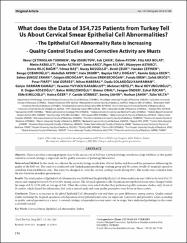| dc.contributor.author | Çetinaslan Türkmen, İlknur | |
| dc.contributor.author | Usubütün, Alp | |
| dc.contributor.author | Çakır, Aslı | |
| dc.contributor.author | Aydın, Özlem | |
| dc.contributor.author | Aka Bolat, Filiz | |
| dc.contributor.author | Akbulut, Metin | |
| dc.contributor.author | Altınay, Serdar | |
| dc.contributor.author | Arıcı, sema | |
| dc.contributor.author | Aslan, Figen | |
| dc.contributor.author | Astarcı, Müzeyyen | |
| dc.contributor.author | Kılıç Bağır, Emine | |
| dc.contributor.author | Baş, Yılmaz | |
| dc.contributor.author | Başsüllü, Nuray | |
| dc.contributor.author | Çelik, Betül | |
| dc.contributor.author | Çetiner, Handan | |
| dc.contributor.author | Çobanoğlu, Bengü | |
| dc.contributor.author | Aydın, Abdullah | |
| dc.contributor.author | Demir, Hale | |
| dc.contributor.author | Tatlı Doğan, Hayriye | |
| dc.contributor.author | Eken, Kamile Gülçin | |
| dc.contributor.author | Şengiz Erhan, Selma | |
| dc.contributor.author | Erdoğan, Gülgün | |
| dc.contributor.author | Eren Erdoğan, Kıvılcım | |
| dc.contributor.author | Eren, Funda | |
| dc.contributor.author | Ersöz, Şafak | |
| dc.contributor.author | Fırat, Pınar | |
| dc.contributor.author | Gürses, İclal | |
| dc.contributor.author | Haberal, Nihan | |
| dc.contributor.author | Solakoğlu Kahraman, Dudu | |
| dc.contributor.author | Harman Kemali, Gülçin | |
| dc.contributor.author | Yuyucu Karabulut, Yasemin | |
| dc.contributor.author | Kefeli, Mehmet | |
| dc.contributor.author | Koyuncuoğlu, Meral | |
| dc.contributor.author | Köseoğlu, R. Doğan | |
| dc.contributor.author | Müezzinoğlu, Bahar | |
| dc.contributor.author | Önal, Binnur | |
| dc.contributor.author | Önder, Sevgen | |
| dc.contributor.author | Özcan, Zuhal | |
| dc.contributor.author | Kımıloğlu, Elife | |
| dc.contributor.author | Özer, Hatice | |
| dc.contributor.author | Sönmez, F. Cavide | |
| dc.contributor.author | Şahin, Sevinç | |
| dc.contributor.author | Şahin, Nurhan | |
| dc.contributor.author | Yalta, Tülin | |
| dc.date.accessioned | 10.07.201910:49:13 | |
| dc.date.accessioned | 2019-07-10T20:03:59Z | |
| dc.date.available | 10.07.201910:49:13 | |
| dc.date.available | 2019-07-10T20:03:59Z | |
| dc.date.issued | 2017 | en_US |
| dc.identifier.citation | Çetinaslan Türkmen, İ., Usubütün, A., Çakır, A., Aydın, Ö., Aka Bolat, F., Akbulut, M. ... Yalta, T. (2017). What does the data of 354,725 patients from Turkey tell us about cervical smear epithelial cell abnormalities? - The epithelial cell abnormality rate is increasing - Quality control studies and corrective activity are musts. Turkish Journal of Pathology, 33(2), 134-143. https://dx.doi.org/10.5146/tjpath.2016.01380 | en_US |
| dc.identifier.issn | 1018-5615 | |
| dc.identifier.issn | 1309-5730 | |
| dc.identifier.uri | https://dx.doi.org/10.5146/tjpath.2016.01380 | |
| dc.identifier.uri | https://hdl.handle.net/20.500.12511/3976 | |
| dc.description | WOS: 000414649400006 | en_US |
| dc.description | PubMed ID: 28272675 | en_US |
| dc.description.abstract | Objective: There is no other screening program close to the success rate of PAP test. Cervical cytology constitutes a large workload so that quality control in cervical cytology is important for the quality assurance of pathology laboratories. Material and Method: In this study, we collected the cervical cytology results from all over Turkey and discussed the parameters influencing the quality of the PAP test. The study was conducted with Turkish gynaecopathology working group and 38 centers (totally 45 hospitals) agreed to contribute from 24 different cities. The study was designed to cover the cervical cytology results during 2013. The results were evaluated from the data based on an online questionnaire. Results: The total number of Epithelial Cell Abnormality was 18,020 and the global Epithelial Cell Abnormality rate was 5.08% in the total 354,725 smears and ranging between 0.3% to 16.64% among centers. The Atypical squamous cells/Squamous intraepithelial lesion ratios changed within the range of 0.21-13.94 with an average of 2.61. When the centers were asked whether they performed quality assurance studies, only 14 out of 28 centers, which shared the information, had such a control study and some quality parameters were better in these centers. Conclusion: There is an increase in the global Epithelial Cell Abnormality rate and there are great differences among centers. Quality control studies including the Atypical squamous cells/Squamous intraepithelial lesion ratio are important. Corrective and preventive action according to quality control parameters is a must. A cervical cytology subspecialist in every center can be utopic but a dedicated pathologist in the center is certainly needed. | en_US |
| dc.language.iso | eng | en_US |
| dc.publisher | DeGruyter Open Ltd | en_US |
| dc.rights | info:eu-repo/semantics/openAccess | en_US |
| dc.subject | Cervical Smear | en_US |
| dc.subject | Epithelial Cell Abnormality | en_US |
| dc.subject | Turkey | en_US |
| dc.title | What does the data of 354,725 patients from Turkey tell us about cervical smear epithelial cell abnormalities? - The epithelial cell abnormality rate is increasing - Quality control studies and corrective activity are musts | en_US |
| dc.type | article | en_US |
| dc.relation.ispartof | Turkish Journal of Pathology | en_US |
| dc.department | İstanbul Medipol Üniversitesi, Tıp Fakültesi, Cerrahi Tıp Bilimleri Bölümü, Tıbbi Patoloji Ana Bilim Dalı | en_US |
| dc.authorid | 0000-0003-0128-6947 | en_US |
| dc.identifier.volume | 33 | en_US |
| dc.identifier.issue | 2 | en_US |
| dc.identifier.startpage | 134 | en_US |
| dc.identifier.endpage | 143 | en_US |
| dc.relation.publicationcategory | Makale - Uluslararası Hakemli Dergi - Kurum Öğretim Elemanı | en_US |
| dc.identifier.doi | 10.5146/tjpath.2016.01380 | en_US |


















